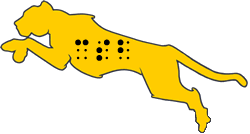Optic Nerve Hypoplasia
What is optic nerve hypoplasia?
The optic nerve sends all vision messages to the brain. Sometimes it does not grow before babies are born. People who are born without the optic nerve growing have optic nerve hypoplasia. If the optic nerve did not grow, vision messages do not get to the brain. Many people who have optic nerve hypoplasia also have septo-optic dysplasia. You can read about septo-optic dysplasia on this web site.
What causes optic nerve hypoplasia?
No one knows what causes optic nerve hypoplasia. Some people who have it have mothers who were very young when they were born. More children are born with optic nerve hypoplasia in areas where food is grown. Maybe the poison used to kill bugs on farms also makes the optic nerve stop growing. Doctors do not know for sure.
What kind of vision do people have who have optic nerve hypoplasia?
Some people who have optic nerve hypoplasia can see a lot. Some cannot see at all. The ones who can see sometimes have a hard time understanding what they see. This is called "perceptual problems."
Sometimes people who have optic nerve hypoplasia can see from part of their retina and not from other parts. Some of the vision messages get to the brain, but not all of them. This is called "field loss." No one can see everything at once. People who are fully sighted have to turn to see what is behind them. People who have a field loss have to move to see things in the place where they have the field loss.
What other problems come with optic nerve hypoplasia?
Optic nerve hypoplasia often comes with something that is called septo-optic dysplasia. You can read about septo-optic dysplasia on this website.
What will help you if you have optic nerve hypoplasia?
This is a list of things that have helped people who have optic nerve hypoplasia. You can try them and decide which ones help you.
- Bright light may help you see. Too much light may make it hard to see. Try to get lights that you can make dim or light. Sit or stand so that the light is behind you or next to you.
- Wear a hat and sunglasses when it is bright outside.
- Sometimes making the background dark and the letters light will help. You can do this on a computer or on a CCTV.
- When you get tired of using your eyes, rest.
- You may want to learn braille. Using touch and listening may help you learn best.
- Using a white cane outdoors may help you. The cane can tell you when there are steps or a curb. It can let you know where things are so that you do not bump into them.
- It may help to make things big. The easy way to make things look bigger is to move them close to you or move yourself close to them. Use a bookstand to hold your book so that you can sit up to look at it up close. Maybe a magnifier will help you see things close to you. You can make print and pictures bigger on the computer, with a CCTV or with a copy machine. Using a monocular telescope may help for looking at things far away.
- Put things on a plain background when you want to see them. It will be easier to see where the things are. Make sure there is space between the things you are looking at. If you are reading, make the letters and lines of words have space between them.
Events
- National Coding Symposium
Tuesday, December 9, 2025 - Winter Concert
Wednesday, December 10, 2025 at 1:30PM
Thursday, December 11, 2025 at 7:00PM - Learning Lab
- Short Courses 2025-2026
- Summer Academies 2026
- General Tours
 (Google Form)
(Google Form)
Please fill out the Google Form if you are interested in attending any of our General Tour days.


